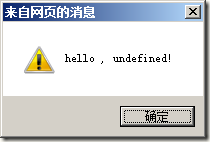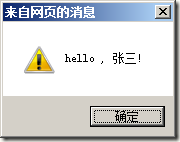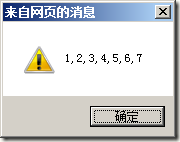javascript 面向对象编程 function是方法(函数)_js面向对象
好程序不是写给computer的,而是写给human的。遇到复杂功能,应该想着把它简化、组件化,把小功能封装成小组件,小功能块可以任意的组合得到千变万化的复杂功能。function就可以帮助我们把功能进行封装。那什么是封装呢。要我说,只要把具体实现给打包,对外提供调用接口那就是封装,方法也好、类也好就做了这些事。
javascript中的function可以用来创建方法、也可以用来创建类,实际上我们可以认为是用function来模拟出的类(说到类一般都会要去了解闭包的知识)。还是先看一下方法吧。
javascript函数分为有名函数、匿名函数和在匿名函数基础上延伸出来的立即执行函数。
普通函数就是用function直接声明的有名函数。
<SPAN class=kwrd>function</SPAN> Hello() {alert(<SPAN class=str>"hello , everybody!"</SPAN>);
};
Hello();
<SPAN class=kwrd>function</SPAN> SayHelloTo(somebody) {alert(<SPAN class=str>"hello , "</SPAN> + somebody + <SPAN class=str>"!"</SPAN>);
};
SayHelloTo(<SPAN class=str>"张三"</SPAN>);
上面分别创建了Hello和SayHelloTo方法。Hello不带有参数,直接通过Hello()来完成调用。SayHelloTo方法带有一个参数,向谁问候时需要知道是在问候谁。在调用SayHelloTo(“张三”)时要传入参数。这些代码和java、C#都没有什么太大区别。在方法重载上却有较大改变,javascript本身并不支持什么重载,一个方法名就对应一个方法。如果强制的写出多个同名方法,其实会出现先写的方法被覆盖掉的情况。
<SPAN class=kwrd>function</SPAN> Hello() {alert(<SPAN class=str>"hello , everybody!"</SPAN>);
};
Hello();
<SPAN class=kwrd>function</SPAN> Hello(somebody) {alert(<SPAN class=str>"hello , "</SPAN> + somebody + <SPAN class=str>"!"</SPAN>);
};
Hello(<SPAN class=str>"张三"</SPAN>);


第一个Hello方法被覆盖掉,执行时直接调用Hello()则认为调用第二个Hello方法但没有传递参数值,所以弹出了undefined信息。调用Hello(“张三”)时很正常的完成执行。其实javascript也可以用一些直白的方式来完成重载。学过C#的人都会知道有个params关键字,通过它可以实现向方法传递不定个数的参数。我们可以通过对参数的信息做手动的判断也可以模拟出类似重载的效果。而在javascript中根本就不需要什么params关键字,就可以很自然的实现任意个数参数的传递。function中有个arguments属性,可以把它看成一个数组,它按传递进来的参数的顺序来保存所有的参数。也就是说我们在定义方法时可以不声明参数名。
<SPAN class=kwrd>function</SPAN> ShowArguments() {<SPAN class=kwrd>var</SPAN> args = <SPAN class=str>""</SPAN>;
<SPAN class=kwrd>for</SPAN> (<SPAN class=kwrd>var</SPAN> i = 0; i < arguments.length; i++) {args += arguments[i] + <SPAN class=str>","</SPAN>;
};
alert(args.substr(0, args.length - 1));
};
ShowArguments(1, 2, 3, 4, 5, 6, 7);
<SPAN class=kwrd>function</SPAN> Hello() { <SPAN class=kwrd>if</SPAN> (arguments.length == 0) {alert(<SPAN class=str>"hello , everybody!"</SPAN>);
}
<SPAN class=kwrd>else</SPAN> {alert(<SPAN class=str>"hello , "</SPAN> + arguments[0] + <SPAN class=str>"!"</SPAN>);
};
};
Hello();
Hello(<SPAN class=str>"张三"</SPAN>);
基于参数个数不同的重载。
<SPAN class=kwrd>function</SPAN> Increase(arg) { <SPAN class=kwrd>if</SPAN> (<SPAN class=kwrd>typeof</SPAN> arg == <SPAN class=str>"undefined"</SPAN>) {alert(<SPAN class=str>"请输入参数"</SPAN>);
}
<SPAN class=kwrd>if</SPAN> (<SPAN class=kwrd>typeof</SPAN> arg == <SPAN class=str>"string"</SPAN>) {alert(String.fromCharCode(arg.charCodeAt(0) + 1));
}
<SPAN class=kwrd>if</SPAN> (<SPAN class=kwrd>typeof</SPAN> arg == <SPAN class=str>"number"</SPAN>) {alert(arg + 1);
}
};
Increase();
Increase(<SPAN class=str>"a"</SPAN>);
Increase(1);
函数除了有名函数之外也可以是匿名函数,匿名函数就是没有名子的函数,不论函数有名还是没有名子,都是一个完整的函数对象。匿名函数还是用function来声明,但不用为它指定名称。其它的方面,比如参数等等和有名函数没什么区别。
<SPAN class=kwrd>function</SPAN>() {……
};
匿名函数一般可以满足临时的函数需求,不需要有变量对其进行引用(有名的函数可以认为是有变量引用的函数)。比如需要一个函数做为值对象做为参数传入方法、需要编程的方式为对象添加事件,用匿名函数都可以很好的完成。当然你也可以单独声明变量来引用某个匿名函数对象,这和普通有名函数就没什么区别了。
<SPAN class=kwrd>function</SPAN> Each(array, fun) { <SPAN class=kwrd>for</SPAN> (<SPAN class=kwrd>var</SPAN> i = 0; i < array.length; i++) {fun(array[i]);
};
};
<SPAN class=kwrd>var</SPAN> nums = [1, 2, 3, 4, 5, 6, 7];
Each(nums, <SPAN class=kwrd>function</SPAN>(arg) {alert(arg);
});
上面代码执行,依次输出数组中的元素。
<SPAN class=rem>//在窗体加载时,在标题上显示当前时间</SPAN>
window.onload = <SPAN class=kwrd>function</SPAN>() {document.title = <SPAN class=kwrd>new</SPAN> Date().toString();
};
<SPAN class=rem>//也可以将匿名方法传入定时器中</SPAN>
setInterval(<SPAN class=kwrd>function</SPAN>() {document.title = <SPAN class=kwrd>new</SPAN> Date().toString();
}, 1000);
使用匿名函数绑定事件和进行定时操作。
<SPAN class=kwrd>var</SPAN> Hello = <SPAN class=kwrd>function</SPAN>() {alert(<SPAN class=str>"hello , everybody!"</SPAN>);
};
如果将匿名函数赋给变量,那和有名的普通函数就没区别了。但不管是变量引用还是普通地有名函数,这样的函数在内存上都持久的占有一定资源。有时候我们只想执行一次大不必使用有引用的函数,直接执行匿名函数可能是最好的选择。把匿名函数包起来,加个括号执行,一切ok,这就是由匿名函数延伸出来的立即执行函数。
(<SPAN class=kwrd>function</SPAN>() {alert(<SPAN class=str>"hello , everybody!"</SPAN>);
})();
(<SPAN class=kwrd>function</SPAN>(somebody) {alert(<SPAN class=str>"hello , "</SPAN> + somebody + <SPAN class=str>"!"</SPAN>);
})(<SPAN class=str>"张三"</SPAN>);
立即执行函数在做事件绑定,设置回调函数等方面往往会有意想不到的效果,可以解决诸如对象引用等问题。
<SPAN class=kwrd>var</SPAN> student = {Name: <SPAN class=str>"张三"</SPAN>,
Age: 20,
Introduce: <SPAN class=kwrd>function</SPAN>() {alert(<SPAN class=str>"我叫"</SPAN> + <SPAN class=kwrd>this</SPAN>.Name + <SPAN class=str>",今年"</SPAN> + <SPAN class=kwrd>this</SPAN>.Age + <SPAN class=str>"岁了!"</SPAN>);
} };
window.onload = (<SPAN class=kwrd>function</SPAN>(obj) { <SPAN class=kwrd>return</SPAN> <SPAN class=kwrd>function</SPAN>() { obj.Introduce(); }; })(student);因为javascript中函数的这些特点加之它的对象的特征,我们还可以写出一些有functional意味的程序出来。其实javascript中function真的是老大。
<SPAN class=kwrd>function</SPAN> Sum(fun, x) {<SPAN class=kwrd>if</SPAN> (x <= 0)
<SPAN class=kwrd>return</SPAN> 0;
<SPAN class=kwrd>return</SPAN> fun(x) + Sum(fun, x - 1);
};
alert(Sum(<SPAN class=kwrd>function</SPAN>(i) { <SPAN class=kwrd>return</SPAN> i * i; }, 100));下面这又是什么呢?是方法吗?是类吗?
<SPAN class=kwrd>function</SPAN> Point() {};
先啰嗦到这,下次再看看类。

熱AI工具

Undresser.AI Undress
人工智慧驅動的應用程序,用於創建逼真的裸體照片

AI Clothes Remover
用於從照片中去除衣服的線上人工智慧工具。

Undress AI Tool
免費脫衣圖片

Clothoff.io
AI脫衣器

Video Face Swap
使用我們完全免費的人工智慧換臉工具,輕鬆在任何影片中換臉!

熱門文章

熱工具

記事本++7.3.1
好用且免費的程式碼編輯器

SublimeText3漢化版
中文版,非常好用

禪工作室 13.0.1
強大的PHP整合開發環境

Dreamweaver CS6
視覺化網頁開發工具

SublimeText3 Mac版
神級程式碼編輯軟體(SublimeText3)
 function是什麼意思
Aug 04, 2023 am 10:33 AM
function是什麼意思
Aug 04, 2023 am 10:33 AM
function是函數的意思,是一段具有特定功能的可重複使用的程式碼區塊,是程式的基本組成單元之一,可以接受輸入參數,執行特定的操作,並傳回結果,其目的是封裝一段可重複使用的程式碼,提高程式碼的可重複使用性和可維護性。
 @JsonIdentityInfo註解在Java中使用Jackson的重要性是什麼?
Sep 23, 2023 am 09:37 AM
@JsonIdentityInfo註解在Java中使用Jackson的重要性是什麼?
Sep 23, 2023 am 09:37 AM
當物件在Jackson庫中具有父子關係時,將使用@JsonIdentityInfo註解。 @JsonIdentityInfo 註解 用於在序列化和反序列化過程中指示物件身分。 ObjectIdGenerators.PropertyGenerator是一個抽象佔位符類,用來表示要使用的物件識別碼來自POJO屬性的情況。語法@Target(value={ANNOTATION_TYPE,TYPE,FIELD,METHOD,PARAMETER})@Retention(value=RUNTIME)public
 PHP高階特性:物件導向程式設計的最佳實踐
Jun 05, 2024 pm 09:39 PM
PHP高階特性:物件導向程式設計的最佳實踐
Jun 05, 2024 pm 09:39 PM
PHP中OOP最佳實務包括命名約定、介面與抽象類別、繼承與多型、依賴注入。實戰案例包括:使用倉庫模式管理數據,使用策略模式實現排序。
 探索Go語言中的物件導向編程
Apr 04, 2024 am 10:39 AM
探索Go語言中的物件導向編程
Apr 04, 2024 am 10:39 AM
Go語言支援物件導向編程,透過型別定義和方法關聯實作。它不支援傳統繼承,而是透過組合實現。介面提供了類型間的一致性,允許定義抽象方法。實戰案例展示如何使用OOP管理客戶訊息,包括建立、取得、更新和刪除客戶操作。
 Golang中有類似類別的物件導向特性嗎?
Mar 19, 2024 pm 02:51 PM
Golang中有類似類別的物件導向特性嗎?
Mar 19, 2024 pm 02:51 PM
在Golang(Go語言)中並沒有傳統意義上的類別的概念,但它提供了一種稱為結構體的資料類型,透過結構體可以實現類似類別的物件導向特性。在本文中,我們將介紹如何使用結構體實現物件導向的特性,並提供具體的程式碼範例。結構體的定義和使用首先,讓我們來看看結構體的定義和使用方式。在Golang中,結構體可以透過type關鍵字定義,然後在需要的地方使用。結構體中可以包含屬
 解析PHP物件導向程式設計中的享元模式
Aug 14, 2023 pm 05:25 PM
解析PHP物件導向程式設計中的享元模式
Aug 14, 2023 pm 05:25 PM
解析PHP物件導向程式設計中的享元模式在物件導向程式設計中,設計模式是一種常用的軟體設計方法,它可以提高程式碼的可讀性、可維護性和可擴充性。享元模式(Flyweightpattern)是設計模式中的一種,它透過共享物件來降低記憶體的開銷。本文將探討如何在PHP中使用享元模式來提升程式效能。什麼是享元模式?享元模式是一種結構型設計模式,它的目的是在不同物件之間共享相同的
 Go語言的物件導向特性解析
Apr 04, 2024 am 11:18 AM
Go語言的物件導向特性解析
Apr 04, 2024 am 11:18 AM
Go語言支援物件導向編程,透過struct定義對象,使用指標接收器定義方法,並透過介面實現多態。物件導向特性在Go語言中提供了程式碼重用、可維護性和封裝,但也存在缺乏傳統類別和繼承的概念以及方法簽章強制型別轉換的限制。
 'enumerate()'函數在Python中的用途是什麼?
Sep 01, 2023 am 11:29 AM
'enumerate()'函數在Python中的用途是什麼?
Sep 01, 2023 am 11:29 AM
在本文中,我們將了解enumerate()函數以及Python中「enumerate()」函數的用途。什麼是enumerate()函數? Python的enumerate()函數接受資料集合作為參數並傳回一個枚舉物件。枚舉物件以鍵值對的形式傳回。 key是每個item對應的索引,value是items。語法enumerate(iterable,start)參數iterable-傳入的資料集合可以作為枚舉物件傳回,稱為iterablestart-顧名思義,枚舉物件的起始索引由start定義。如果我們忽







